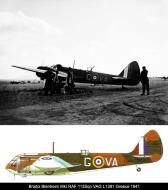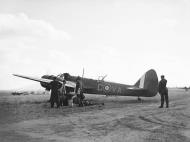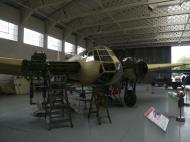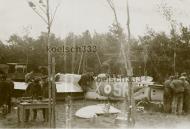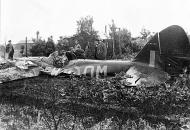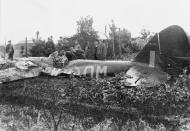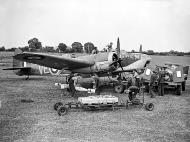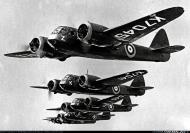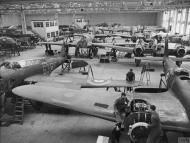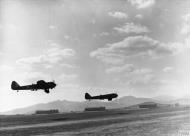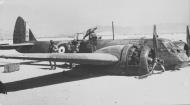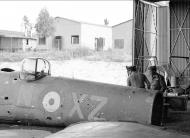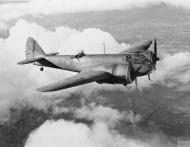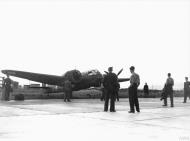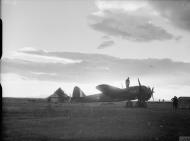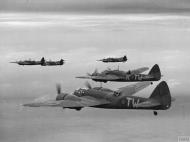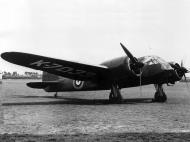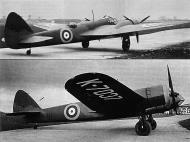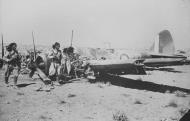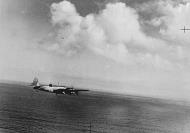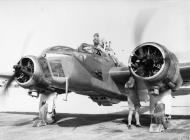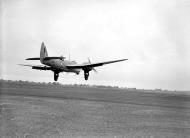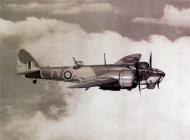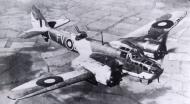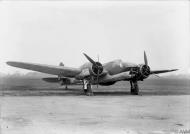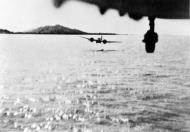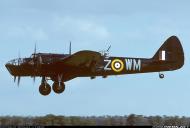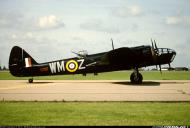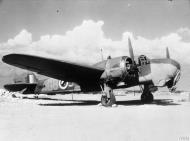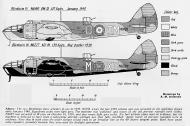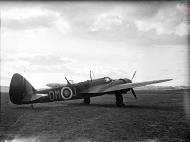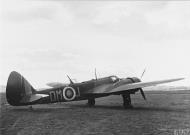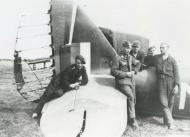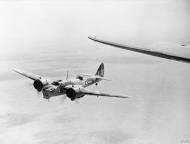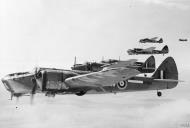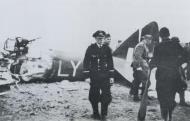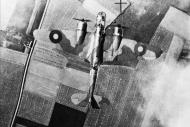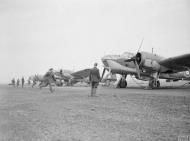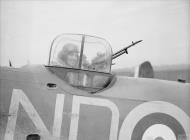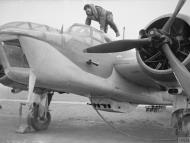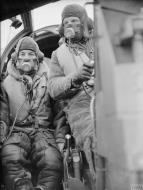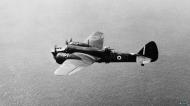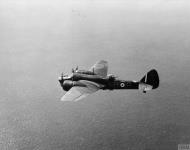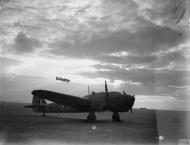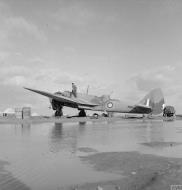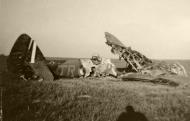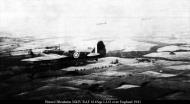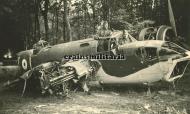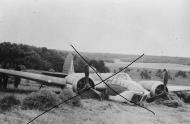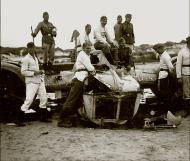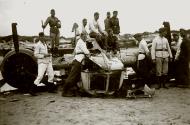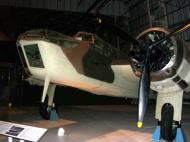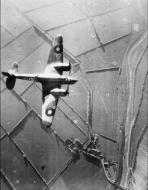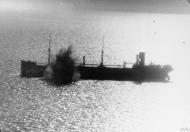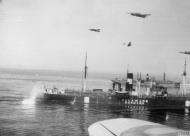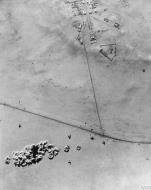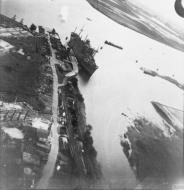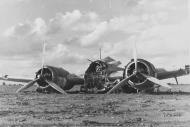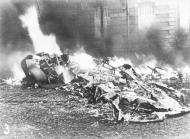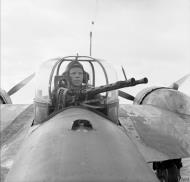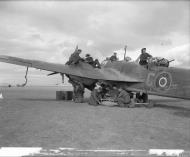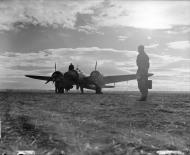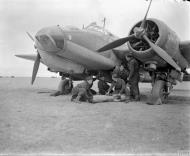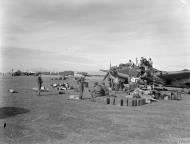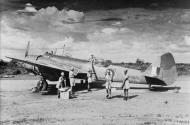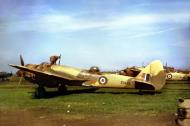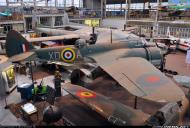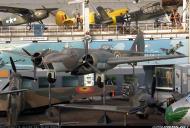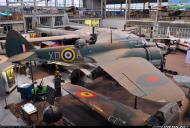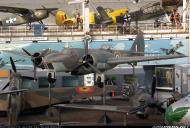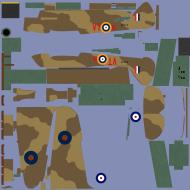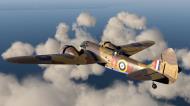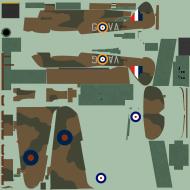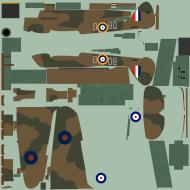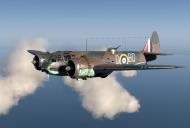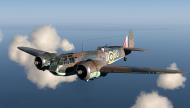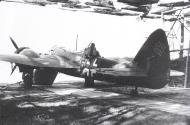Blenheim MkIF RAF 84Sqn VAG L1381 warming up at Menidi Tatoi Greece 1941 IWM CM264
The crew of Bristol Blenheim Mark I, L1381 'VA-G', of No. 84 Squadron RAF, prepare to board their aircraft at Menidi/Tatoi, Greece, for a raid on an Italian port in Albania. L1381 was one of four Blenheims lost during a raid on Valona on 7 December 1941, when it crash-landed near Sarande after being damaged by an Italian fighter.
Imperial War Museum IWM CM 264 https://www.iwm.org.uk/collections/item/object/205208732
Blenheim MkIV RAF 45Sqn U at waterlogged Gambut Libya Nov IWM CM1927
A Bristol Blenheim Mark IV, 'U' (serial number unclear) of No. 45 Squadron RAF, undergoes an engine overhaul at waterlogged Gambut, Libya, after violent rainstorms in November and December 1941 rendered many of the forward airfields unusable during Operation CRUSADER.
Imperial War Museum IWM CM 1927 https://www.iwm.org.uk/collections/item/object/205208889
Blenheim MkV RAF 34Sqn N BA576 at an airstrip in north-eastern India IWM CI295
A mobile X-ray unit of the Indian Army Medical Corps is unloaded from Bristol Blenheim Mark V, BA576 'N', of No. 34 Squadron RAF at an airstrip in north-eastern India
Imperial War Museum IWM CI 295 https://www.iwm.org.uk/collections/item/object/205209568
Blenheim MkI RAF 2 School of Technical Training at Cosford Feb 1940 IWM HU106262
Fairey Battles and Bristol Blenheims being used for maintenance instruction at No. 2 School of Technical Training at Cosford, February 1940.
Imperial War Museum IWM HU 106262 https://www.iwm.org.uk/collections/item/object/205234772
Blenheim MkIF RAF 604Sqn NG at Northolt Apr 1940 IWM HU106272
The crew of a Bristol Blenheim Mk 1F of No. 604 Squadron climb from their aircraft at Northolt, April 1940.
Imperial War Museum IWM HU 106272 https://www.iwm.org.uk/collections/item/object/205234773
Blenheim MkI RAF 90Sqn TWK in flight 1938 IWM HU106277
Blenheim Mk Is of No. 90 Squadron in flight, circa 1938.
Imperial War Museum IWM HU 106277 https://www.iwm.org.uk/collections/item/object/205234780
Blenheim MkIF RAF 17OTU WRW L1359 at Upwood 1940 IWM HU107771
Aircrew with Blenheim Mk IF L1359 'WR-W' at an OTU in the Midlands, 1940. Probably No. 17 OTU at Upwood.
Imperial War Museum IWM HU 107771 https://www.iwm.org.uk/collections/item/object/205234780
Bristol Blenheim MkIV RAF 14Sqn W Z5893 over the Western Desert IWM CM3108
A formation of five Blenheim Mark IVs (Z5893 'W' nearest) of No. 14 Squadron RAF in flight over the Western Desert. A Curtiss Kittyhawk, one of the escorting fighters, can be seen on the far right.
Imperial War Museum IWM CM 3108 https://www.iwm.org.uk/collections/item/object/205126793
Blenheim MkIV RAF 45Sqn A V6149 at Gambut Libya IWM CM2037
A Bristol Blenheim Mark IV returns to Gambut, Libya, in the failing evening light, after completing a sortie. In the foreground, Blenheim Mark IV, V6149 'A', of No. 45 Squadron RAF has been 'bedded down' for the night with tarpaulin covers over the engines and nose section.
Imperial War Museum IWM CM 2037 https://www.iwm.org.uk/collections/item/object/205208892
Blenheim MkIVs RAF 270 Wing bomb El Magrun Libya operation CRUSADER Dec 1941 IWM CM2017
Bombs from Bristol Blenheim Mark IVs of No. 270 Wing RAF explode among Junkers Ju 52s parked on the landing ground at El Magrun, Libya, in the afternoon of 22 December 1941. Blenheims, from Nos, 14 and 84 Squadrons RAF and the Lorraine Squadron of the Free French Air Force, made a series of attacks on El Magrun on 21-22 December, which was being used extensively by the Luftwaffe to provide air support for their retiring ground forces during operation CRUSADER.
Imperial War Museum IWM CM 2017 https://www.iwm.org.uk/collections/item/object/205022962
Blenheim MkIVs hit an Italian motor vessel Mediterranean IWM C1912
A bomb explodes by the side of an Italian motor vessel, under attack from Bristol Blenheim Mark IVs in the Mediterranean.
Imperial War Museum IWM C 1912 https://www.iwm.org.uk/collections/item/object/205023057
Blenheim MkIVs RAF 105Sqn and 139Sqn off the Dutch coast IWM C1936
Low level oblique taken during an attack on an enemy convoy off the Dutch coast by Bristol Blenheim Mark IVs of No, 2 Group. Eight vessels sailing between Ijmuiden and the Hague were intercepted by aircraft drawn from Nos. 105 and 139 Squadrons RAF. Although hits were scored on the ships, 3 Blenheims were shot down and 2 crash-landed on return to their base. Here, bombs can be seen narrowly missing MV DELAWARE, a Danish-registered vessel as aircraft attack at low level. The photograph was taken from the mid-upper gun turret of another Blenheim.
Imperial War Museum IWM C 1936 https://www.iwm.org.uk/collections/item/object/205023062
Bristol Blenheim MkI RAF 84Sqn VAO at Menidi-Tatoi Greece IWM MERAF336
Ground crew run an engine test on Bristol Blenheim Mark I 'VA-O', of No. 84 Squadron RAF at Menidi/Tatoi, Greece.
Imperial War Museum IWM ME(RAF) 336 https://www.iwm.org.uk/collections/item/object/205212042
Bristol Blenheim MkIV RAF 245Sqn at RAF Aldergrove Northern Ireland IWM HU107158
Three Bristol Blenheim long range fighters of No. 245 (Northern Rhodesian) Squadron at RAF Aldergrove, Northern Ireland.
Imperial War Museum IWM HU 107158 https://www.iwm.org.uk/collections/item/object/205259259
Bristol Blenheim MkIV RAF 245Sqn at RAF Aldergrove Northern Ireland IWM HU107159
A close up view of the turret on a Bristol Blenheim long range fighter of No. 245 (Northern Rhodesian) Squadron at RAF Aldergrove, Northern Ireland.
Imperial War Museum IWM HU 107159 https://www.iwm.org.uk/collections/item/object/205259260
Bristol Blenheim MkIV RAF 245Sqn at RAF Aldergrove Northern Ireland IWM HU107160
The observer climbing into the cockpit of a Bristol Blenheim long range fighter of No. 245 (Northern Rhodesian) Squadron at RAF Aldergrove, Northern Ireland.
Imperial War Museum IWM HU 107160 https://www.iwm.org.uk/collections/item/object/205259261
Bristol Blenheim MkIV RAF 245Sqn at RAF Aldergrove Northern Ireland IWM HU107161
The pilot and the observer in the cabin of a Bristol Blenheim long range fighter of No. 245 (Northern Rhodesian) Squadron at RAF Aldergrove, Northern Ireland.
Imperial War Museum IWM HU 107161 https://www.iwm.org.uk/collections/item/object/205259262
Bristol Blenheim MkI RAF 54OTU L1295 RAF Cranwell IWM CH655
Bristol Blenheim Mark I, L1295 in flight above the clouds. This aircraft commenced service in August 1938 with No. 107 Squadron RAF, followed by No. 600 Squadron RAF, the Royal Aircraft Establishment, No. 54 Operational Training Unit, RAF Cranwell, No. 3 Radio School, and finally No. 12 (Pilots) Advanced Flying Unit, with whom she was damaged beyond repair after crash-landing at Harlaxton on 29 July 1943. For reasons not known, the fuselage roundel and unit code were painted out at the time this photograph was taken.
Imperial War Museum IWM CH 655 https://www.iwm.org.uk/collections/item/object/205209975
Bristol Blenheim MkIV at a Maintenance Unit in Egypt IWM MERAF1473
Fitters running up and checking the Bristol Mercury XV engines of a Bristol Blenheim Mark IV at a Maintenance Unit in Egypt, before releasing it for operational service. Note the Vokes air filters over the carburettor intakes under the engines, and the four .303 machine-gun pack fitted beneath the fuselage.
Imperial War Museum IWM ME(RAF) 1473 https://www.iwm.org.uk/collections/item/object/205208836
Bristol Blenheim MkI RAF 30Sqn taking off from Eleusis, Greece IWM MERAF1101
Two Bristol Blenheim Mark Is of 'A' Flight No. 30 Squadron RAF, taking off from Eleusis, Greece, for a bombing raid over Italian-occupied Albania. Both aircraft are carrying external bomb loads in the Light Series Carriers fitted under the fuselage.
Imperial War Museum IWM ME(RAF) 1101 https://www.iwm.org.uk/collections/item/object/205208835
Bristol Blenheim MkIV RAF 105Sqn GBJ V6014 at Luqa Malta IWM CM1357
Bristol Blenheim Mark IV, V6014 'GB-J', of No. 105 Squadron RAF Detachment in a dispersal at Luqa, Malta. Canvas covers protect the cockpit and glazed nose section from the sun. From July to September 1941, 105 Squadron was detached from the United Kingdom to Malta, to operate against targets in the Mediterranean and North Africa, losing 14 aircraft during the period. Note the modified gun mounting under the nose.
Imperial War Museum IWM CM 1357 https://www.iwm.org.uk/collections/item/object/205208814
Bristol Blenheim MkIVs attack on Ypenburg airfield Holland 1940 IWM C1781
Composite of two aerial photographs taken during an attack on Ypenburg airfield, Holland, by Bristol Blenheim Mark IVs of the Advanced Air Striking Force. 250-lb GP bombs can be seen falling over the main Delft-Den Haag road onto the airfield where two Focke-Wulf Fw 58 are parked near the hangars. The bomb craters on and around the site were made during Luftwaffe attacks immediately prior to the German invasion.
Imperial War Museum IWM C 1781 https://www.iwm.org.uk/collections/item/object/205023012
Bristol Blenheim MkIV RAF 226Sqn over England 18 Aug 1941 IWM CH8605
A Bristol Blenheim Mark IV of No. 226 Squadron demonstrates the effectiveness of its camouflage as it flies over the English countryside, 18 August 1941.
Imperial War Museum IWM CH 8605 https://www.iwm.org.uk/collections/item/object/205023014
Bristol Blenheim MkVD RAF 614Sqn P BA783 dispersal area at Canrobert Algeria IWM CNA105
Armourers of No. 614 Squadron RAF preparing to load a 250-lb GP bomb into Bristol Blenheim Mark VD, BA783 'P', at Canrobert, Algeria.
Imperial War Museum IWM CNA 105 https://www.iwm.org.uk/collections/item/object/2052091758
Bristol Blenheim MkVD RAF 13Sqn C dispersal area at Canrobert Algeria IWM CNA108
Fitters, armourers and mechanics of No. 13 Squadron RAF prepare Bristol Blenheim Mark VD 'C' for a sortie at Canrobert, Algeria.
Imperial War Museum IWM CNA 108 https://www.iwm.org.uk/collections/item/object/2052091758
Bristol Blenheim MkVD RAF 326 Wing dispersal area at Canrobert Algeria IWM CNA110
A Bristol Blenheim Mark VD of No. 326 Wing RAF, silhouetted against the sun as it undergoes maintenance at Canrobert, Algeria.
Imperial War Museum IWM CNA 110 https://www.iwm.org.uk/collections/item/object/2052091758
Blenheim MkVD RAF 614Sqn refuelling at Blida Algeria IWM CNA51
Bristol Blenheim Mark VDs of No. 614 Squadron RAF undergoing maintenance and refuelling at Blida, Algeria, in preparation for a sortie.
Imperial War Museum IWM CNA 51 https://www.iwm.org.uk/collections/item/object/205209483
Blenheim MkI RAF 84Sqn X L8374 at Menidi Tatoi Greece 22 Dec 1940 IWM CM306
The sun rises over the airfield at Menidi/Tatoi, Greece, as groundcrew remove the covers from Bristol Blenheim Mark I, L8374 'X', of No. 84 Squadron RAF, for a morning raid over Albania. L8374 was one of two Blenheims shot down when nine aircraft of the Squadron bombed the Kucera oil fields on 22 December 1940.
Imperial War Museum IWM CM 306 https://www.iwm.org.uk/collections/item/object/205208734
Bristol Blenheim IV RAF 110Sqn at Wattisham Aug 1940 IWM HU104641
A Bristol Blenheim Mk IV of No. 110 Squadron running up its engines at Wattisham, August 1940.
Imperial War Museum IWM HU 104641 https://www.iwm.org.uk/collections/item/object/205229844
Blenheim MkIV RAF 110Sqn VEA R3741 at Wyton Huntingdonshire IWM CH775A
Blenheim MkIV RAF VEA R3741 Q.6 Petrel P5634 of the RAF Northolt Station Flight, parked alongside Bristol Blenheims at Wyton, Huntingdonshire.
Imperial War Museum IWM CH 775A https://www.iwm.org.uk/collections/item/object/205126770
Bristol Blenheim IV RAF 110Sqn VEA R3741 at Wyton Huntingdonshire IWM CH776
Percival Q.6 Petrel, P5634, of the RAF Northolt Station Flight, parked at the head of a line of Bristol Blenheim Mark IVs of No. 2 Group at Wyton, Huntingdonshire. R3741 'VE-A' of No. 110 Squadron RAF has been modified by the addition of gun mountings in the rear of the engine nacelles, while T1947 'LS' of No. 15 Squadron RAF has been fitted with a long gun tray beneath the nose.
Imperial War Museum IWM CH 776 https://www.iwm.org.uk/collections/item/object/205022889
Bristol Blenheim I RAF 107Sqn OMW V6193 crashsite at Bremen IWM HU25727
Operation WRECKAGE: low level daylight attack on targets in Bremen by aircraft of No. 2 Group. Luftwaffe and German fire brigade personnel inspect the wreckage of Bristol Blenheim Mark IV 'OM-W' of No. 107 Squadron RAF which crashed at Bremen Blockland after being hit by anti aircraft fire over the target area. This aircraft is probably V6193, the pilot of which, Flight Lieutenant F Wellburn, survived, but the remaining three crew members of which, including the Station Armament Officer who went along 'for the experience', were killed.
Imperial War Museum IWM HU 25727 https://www.iwm.org.uk/collections/item/object/205127093
Blenheims RAF 2 Group hit a 500-ton German vessel over Heligoland Bight IWM C1995
Oblique aerial photograph showing a 500-ton German vessel burning after a direct hit amidships during an attack by Bristol Blenheims of No. 2 Group on a convoy of six enemy ships in Heligoland Bight. Taken from the mid-upper turret of one of the attacking aircraft.
Imperial War Museum IWM CM 1995 https://www.iwm.org.uk/collections/item/object/205023069
Bristol Blenheim IV RAF 110Sqn VEH or N R3600 at RAF Wattisham Suffolk IWM CH354
Bristol Blenheim Mark IV, R3600, of No. 110 Squadron RAF, undergoes an elaborate servicing for the photographer at RAF Wattisham, Suffolk. Armourers unload 250-lb GP bombs and Small Bomb Containers (SBCs) of incendiaries from a trolley, while other groundcrew refuel the aircraft and attend to the engines, the cockpit and the gun-turret, accompanied by a pet dog on the engine cowling. 17 days later, on 06/05/1941, BB IV R3600 VE, 110Sq, took off from Wattisham for shipping sweep in ’Beat 7’, crashed in North Sea off Dutch Coast. Crew: pilot F/Lt Edwards N Steel (pilot RAF) age 24 from Wellington (NZ); Sgt Ronald A Freestone (Obs) (both named Runnymede); Sgt Joseph D Bramhall (WOp/AG RAF) age 33 from Glasgow &buried Sage, Germany. Upsetting, but read this to get some understanding of how aircrew are feeling. GW: 18/04/1941, R2787, 110Sq. FTR: took off Watton on anti-shipping sortie, struck tree airfield perimeter, crashed, destroyed by fire. Sgt H Wright, Sgt N Kendall & F/Sgt G Cornwall KIA. 06/05/1941, R3600, 110Sq. FTR Shot down by flak during anti-shipping sortie. F/Lt E Steel (NZ), F/Sgt R Freestone & Sgt J Bramhall KIA. Named on Runnymede.
Further: During the spring and summer of 1940 it was the Blenheims of No 2 Group which sustained the heaviest losses—nearly 6 per cent of sorties flown. Operating chiefly by day, they were used to support the withdrawal of British forces from France and then to harass ports where an invasion fleet might be assembled. In June their operations were extended to Germany with the intention of preventing the deployment of some Luftwaffe fighter units to the Channel coast. Maximum bomb load was 1,000 lb for a 600-mile radius of action. No 110 Squadron's R3600 is here being armed with 250 lb HE bombs and SBCs (small bomb containers) of 416 incendiaries at Wattisham in June 1940. Apparently it is being refuelled at the same time, ground crew attention is more numerous than usual and included is a squadron pet—all of which suggests a special display for the photographer. This aircraft survived until 6 May the following year when it was shot down while attacking a convoy. (IWM CH364)
By the time it was lost, it was credited with 48 operational sorties. Its last crew was
F/L Edward Nation Steel, age 24, RAF, Pilot
F/S Ronald Albert Freestone, RAFVR, Observer
Sgt Joseph Dennis Bramhall, RAFVR, WOp/AG (information from Sara Mosher)
Imperial War Museum IWM CH 364 https://www.iwm.org.uk/collections/item/object/205208469
Web Source http://blenheimsociety.com/wp-content/uploads/2017/05/BB-Journal-30-39-list-of-contents-for-Web-Site.pdf
Web Source http://www.airpages.ru/eng/uk/blenheim_2.shtml
Blenheim IVF RAF 248Sqn WRL N6239 at North Coates Lincolnshire IWM MH42
Blenheim Mark IVF, N6239 WR-L, of No. 248 Squadron RAF, on the ground at North Coates, Lincolnshire.
Imperial War Museum IWM MH 42 https://www.iwm.org.uk/collections/item/object/205183325
Blenheim IVF RAF 248Sqn WRL N6239 at North Coates Lincolnshire IWM MH42
Blenheim Mark IVF, N6239 WR-L, of No. 248 Squadron RAF, on the ground at North Coates, Lincolnshire.
Blenheim MkIF RAF RAF 600Sqn BQN L1517 sd by 11./(N)JG2 Steinhoff at Wassenaar NL 10th May 1945 01
Photo: Bristol Blenheim Mk.1F L1517 (NG-B) of 604 (County of Middlesex) Sqaudron, RAF: Lost on combat operations - officially described as "Blenheim L1514 lost in air operations over Rotterdam, The Netherlands, 10 May 1940". Mission: Escort for the Bristol Blenheims of No. 110 Squadron to Ockenburg, Netherlands. 12 Blenheim Mk.IVs of 110 Squadron were escorted by 6 Blenheim Mk.1Fs of 604 Squadron. Took off from Northolt. Forced-landed on beach at Scheveningen damaged by flak, at 17.30 hrs. Aircraft abandoned North of Scheveningen Beach, in the Sand Dunes at Wassenaar. Both crew - Pilot Officer R C Haine and Pilot Officer M Kramer: originally posted as missing, later reported as safe and returned to unit
Royal Air Force Aircrft L1000-L9999 (James J .Halley, Air Britain, 1978 p 10
Citations
- Wheeler 1992, p. 20.
- Barnes 1964, p.258.
- Barnes 1964, p. 259.
- Barnes 1964, pp. 266–267.
- Gunston, Bill. Classic World War II Aircraft Cutaways. London: Osprey, 1995. ISBN 1-85532-526-8.
- Mason 1994, p. 269.
- Falconer 1998, p. 212.
- Warner 2005, p. 158.
- Warner 2005, pp. 155-158.
- Ramsay 1989, p. 552.
- Ramsay 1989, p. 555.
- Warner 2005, p. 255.
- Warner 2005.
- 'Obituary of Wing Commander Tom Baker.' Daily Telegraph, 10 April 2006.
- David Frith 1987, p. 365.
- Gardner. James. 'Bristol Blenheims' (Pencil and watercolour on board, 1941). National Archives. Retrieved: 22 July 2008.
- "Bristol" Blenheim' (A bibliography of the raid). blenheimsociety.org. Retrieved: 22 July 2008.
- 'Photograph: Blenheim V6391 after bombing Goldenburg Power Station, Cologne.' worldwar2database.com. Retrieved: 25 July 2008.
- 'Photograph: Blenheims Attack Fortuna Power Station in Cologne.' worldwar2database.com. Retrieved: 25 July 2008.
- Lake 1998, pp. 89–90.
- Sakaida 1997, p. 27.
- Jefford 2001
- Perttula, Pentti. 'Bristol Blenheim.' Backwoods Landing Strip: Finnish Air Force Aircraft, FAF in Colour. Retrieved: 27 June 2009.
- Ciglic and Savic 2002, p. 62.
- 'Blenheim may be a write-off.' Air Classics, November 2003. Retrieved: 8 March 2010.
- 'Keski-Suomen Ilmailumuseon (The Aviation Museum of Central Finland).' k-silmailumuseo.fi. Retrieved: 21 July 2010.
- 'Μουσείο Πολεμικής Αεροπορίας (Hellenic Airforce Museum).' haf.gr. Retrieved: 18 April 2012.
- March 1998, p. 43.
Bibliography:
- Air Ministry Pilot's Notes: Blenheim. London: OHMS/Air Data Publications, 1939.
- Air Ministry Pilot's Notes: Blenheim V. London: OHMS/Air Data Publications, 1942.
- Barnes, C.H. Bristol Aircraft Since 1910. London: Putnam, 1970. ISBN 0-85177-804-6.
- Boiten, T. Bristol Blenheim. Ramsbury, Marlborough, Wiltshire, UK: The Crowood Press, 1998. ISBN 1-86126-115-2.
- Bowyer, C. Bristol Blenheim. London: Ian Allen, 1984. ISBN 0-7110-1351-9.
- Chorley, W.R. RAF Bomber Command Losses of the Second World War: 1939-40 v. 1. Earl Shilton, Leicester, UK: Midland Publishing, 1998. ISBN 978-0-904597-85-1.
- Ciglic, Boris and Dragan Savic.Croatian Aces of World War II (Osprey Aircraft of the Aces - 49). London: Oxford, 2002. ISBN 1-84176-435-3.
- Donald, David. The Complete Encyclopedia of World Aircraft. New York: Barnes & Noble, 1997. ISBN 0-7607-0592-5.
- Falconer, Jonathon. The Bomber Command Handbook 1939-1945. Stroud, UK: Sutton Publishing Limited, 1998. ISBN 978-0-7509-1819-0.
- Frith, David. Pageant of Cricket. Melbourne: The MacMillian Company of Australia, 1987. ISBN 978-0-333-45177-9.
- Keskinen, Kalevi et al. Suomen Ilmavoimien Historia 10, Bristol Blenheim (in Finnish). Loviisa, Finland: Painoyhtymä Oy, 2004. ISBN 952-99432-1-0.
- Jefford, C.G. RAF Squadrons: A Comprehensive Record of the Movement and Equipment of All RAF Squadrons and Their Antecedents Since 1912. Shrewsbury, UK: Airlife Publishing 2001. ISBN 1-84037-141-2.
- Lake, Jon. Blenheim Squadrons of World War 2. Oxford, UK: Osprey Publishing, 1998. ISBN 1-85532-723-6.
- Mackay, Ron. Bristol Blenheim in Action. Carrollton, Texas: Squadron/Signal Publications, 1998. ISBN 0-89747-209-8.
- March, Daniel J., ed. British Warplanes of World War II. London: Aerospace, 1998. ISBN 1-874023-92-1.
- Marttila, Jukka. Bristol Blenheim - Taitoa ja tekniikkaa (in Finnish). Vantaa, Finland: Blenimi-Publishing, 1989. ISBN 952-90-0170-3.
- Mason, Francis K. The British Bomber Since 1914. London: Putnam Aeronautical Books, 1994. ISBN 0-85177-861-5.
- Mondey, David. The Hamlyn Concise Guide to American Aircraft of World War II. London: Aerospace Publishing Ltd, 1996. ISBN 0-7858-1361-6.
- Sakaida, Henry. Japanese Army Air Force Aces 1937-45. Oxford, UK: Osprey Publishing, 1997. ISBN 1-85532-529-2.
- Thomas, A. Bristol Blenheim (Warpaint No. 26). London: Hall Park Books, 2000. ISBN 1-84176-289-X.
- Warner, G. The Bristol Blenheim: A Complete History. London: Crécy Publishing, 2nd edition 2005. ISBN 0-85979-101-7.
- Wheeler, Barry C. The Hamlyn Guide to Military Aircraft Markings. London: Chancellor Press, 1992. ISBN 1-85152-582-3.
Magazine References: +
- Airfix Magazines (English) - http://www.airfix.com/
- Avions (French) - http://www.aerostories.org/~aerobiblio/rubrique10.html
- FlyPast (English) - http://www.flypast.com/
- Flugzeug Publikations GmbH (German) - http://vdmedien.com/flugzeug-publikations-gmbh-hersteller_verlag-vdm-heinz-nickel-33.html
- Flugzeug Classic (German) - http://www.flugzeugclassic.de/
- Klassiker (German) - http://shop.flugrevue.de/abo/klassiker-der-luftfahrt
- Le Fana de L'Aviation (French) - http://boutique.editions-lariviere.fr/site/abonnement-le-fana-de-l-aviation-626-4-6.html
- Le Fana de L'Aviation (French) - http://www.pdfmagazines.org/tags/Le+Fana+De+L+Aviation/
- Osprey (English) - http://www.ospreypublishing.com/
- Revi Magazines (Czech) - http://www.revi.cz/
Web References: +
- History of RAF Organisation: http://www.rafweb.org
- Wikipedia, the free encyclopedia: http://en.wikipedia.org/
 Editor for Asisbiz: Matthew Laird Acred
Editor for Asisbiz: Matthew Laird Acred
If you love our website please add a like on facebook
Please donate so we can make this site even better !!


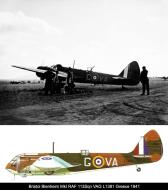
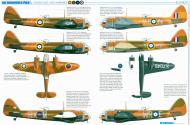
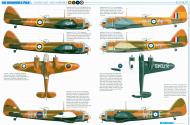
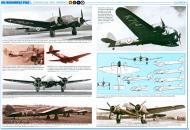
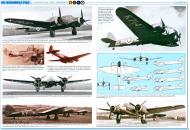
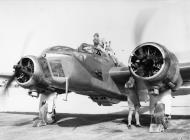
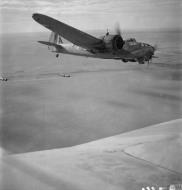
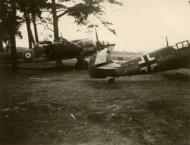
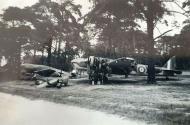
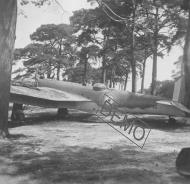
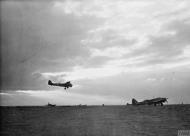
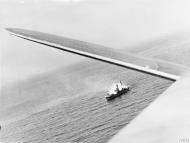
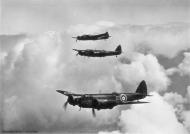
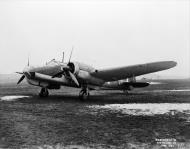
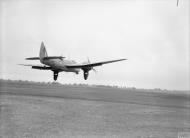
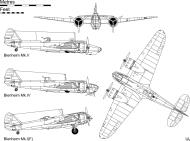
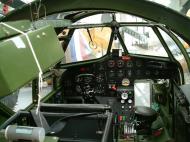
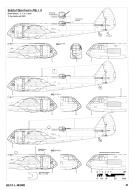
.jpg)
.jpg)
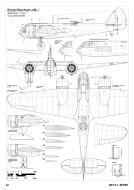
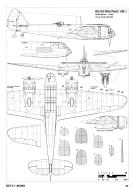


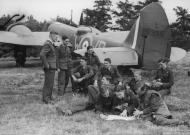
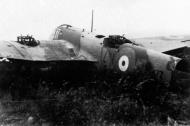
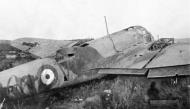
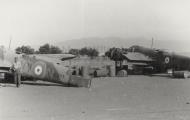

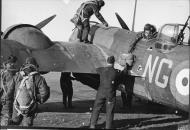
JG2-Johannes-Steinhoff-Wassenaar-Holland-10th-May-1940-01.jpg)
